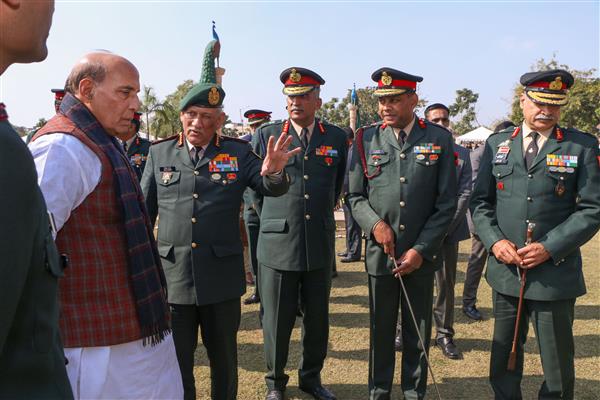National
The Third Eye: Validation of the new laws
New Delhi, May 11 (IANS) The Chief Justice of India, D.Y. Chandrachud, addressing a conference in New Delhi on “Advance of Criminal Justice System”, on April 20, lauded the new Penal Codes enacted by the Parliament in December last year, described the development as a “watershed moment” and expressed satisfaction that India was changing in synchronisation with our times.
He felt that implementation of the new laws would mark a significant overhaul of the criminal justice system to better protect the interests of victims and ensure a more efficient conduct of investigation and prosecution.
He emphasised the urgent need for capacity building in areas of forensic expertise, reorientation of investigating officers and investment in our court system.
It may be mentioned that with the avowed objective of freeing the country of the colonial hangover on the justice system, the Indian Parliament re-designated the Indian Penal Code, 1860; Indian Evidence Act, 1872; and Criminal Procedure Code, 1973, as Bharatiya Nyaya Samhita Act, Bharatiya Sakshya Act, and Bharatiya Nagarik Suraksha Samhita Act, respectively.
The Chief Justice declared that the enactment of these laws by Parliament “underscored India’s evolving dynamics and the pressing need for innovative legal mechanisms to address contemporary challenges”.
In bolstering the concept of punishment acting as a deterrent against crime, the new law lays down the death penalty for the rape of a minor and also for “lynching” — the two black marks of the contemporary crime scenario in India.
The Act replaced the Indian Penal Code of 1860 repealed 22 old sections, added 8 new ones and amended as many as 175 others.
A new Section 69 punishes indulgence in sexual intercourse through deception by way of making promises of marriage while concealing identity.
“Snatching” has been made a distinct offence and a severe penalty was prescribed for disseminating false information through spoken words, signs or electronic means. This latter is also meant to check criminal misuse of social media.
The new code for the first time punishes an act of “terrorism” that was likely to threaten India’s unity, integrity, security, sovereignty or economy or spread terror among the people domestically or abroad.
There has been some expression of concern by civil society groups — particularly those building a narrative of “authoritarianism” against the present government — that the definition of terror activity was being stretched to punish “anti-regime” criticism.
There is no doubt, however, in the minds of average citizens that in this era of proxy wars, advocacy of violence against a legitimate democratic government deserved to be viewed seriously.
In what can be regarded as a progressive move for dispensing justice, community service has been included as a punishment for first-time offenders committing a petty crime.
Besides, a new definition of “organised crime” has been incorporated in the Bharatiya Nyaya Samhita Act to include among other things, kidnapping, human trafficking and cyber crimes carried out to secure material benefit.
The activities of members of an organised crime syndicate are punishable with imprisonment of a minimum of five years — going up to a life sentence if there was no death — and, including capital punishment if a death was caused.
The new Bharatiya Nagarik Suraksha Samhita Act has repealed 9 sections of the old Act, introduced 9 new sections and modified 160 earlier sections. It mandates forensic investigation for crimes punishable with imprisonment of seven years or more. It requires forensic experts to visit the scene of crime, gather clues and document the process.
Electronic mode of giving evidence is permitted at trials, enquiries and proceedings under Section 173 and it is laid down under Section 356 that a judgement can be pronounced in the absence of a proclaimed offender who had avoided the trial.
A great reform is the introduction of the concept of Zero FIR to be registered by a police station on receiving a complaint even if it did not have the jurisdiction, for being forwarded to the right police station. The new Act establishes deadlines for framing of charges and prescribes communicating the progress of the investigation to the victims within 90 days of the complaint.
The Bharatiya Sakshya Act replaced the Indian Evidence Act of 1872 after introducing one new section, removing 5 sections and altering a total of 23 other sections. In a pathbreaking reform, it recognises electronic records as primary evidence under Section 57 and permits electronic presentation of oral evidence enabling remote testimony.
It expands the concept of joint trial under Section 24 of multiple people — some of whom might have failed to respond to an arrest warrant. An important advance is the direction the Act gives for audio-visual recording of search and seizures to protect civil liberties.
Judicial scrutiny of the same would safeguard the rights of citizens against procedural improprieties committed during search and seizure.
Legal minds particularly of the opposition, have expressed misgivings that many of the new provisions endangered civil liberties and enhanced the power of the police over citizens in certain key areas.
Under the Bharatiya Nagarik Suraksha Samhita Act and the Bharatiya Sakshya Act, police officers could compel the accused persons to produce their digital devices for accessing their contents — the rules about how to handle these devices were still not laid down — and the concern was that police could look into privileged communications of the accused with their lawyers and their spouses which were otherwise protected.
For offences with a maximum punishment of three to seven years of imprisonment, the police are permitted to conduct a preliminary inquiry within 14 days of the complaint to decide whether an FIR was to be registered — this seemed to be against the judicial mandate that FIR had to be registered on any complaint alleging a cognisable offence.
It is apprehended that this might allow the police to refuse to register an FIR even on a legitimate complaint.
The provisions made in the new laws can improve the justice system but they could also be put to misuse by the authorities wielding power. Supervision of senior officers should be able to check the latter.
With time under judicial scrutiny, hopefully, the pathway to improvement will be opened up.
The introduction of two new offences in the Bharatiya Nyaya Samhita that did not exist in the Indian Penal Code, have invited an acrimonious debate in human rights groups. They relate to a “terrorist act” and an act “endangering sovereignty, unity and integrity of India”.
It is said that the definition of a “terrorist” act was the same as provided in the Unlawful Activities (Prevention) Act which was worded loosely enough to allow police to book political dissidents. It punishes even the “advice” and “incitement” to do something that amounted to a threat to India’s unity, integrity, sovereignty, security and economy.
Further, the inclusion of the offence of publishing “false” or “misleading” information jeopardising the sovereignty, unity, integrity and security of India — it is alleged — would enable the state to target media outlets and journalists who revealed information inconvenient to the government.
In a nutshell, some of the new laws have been run down by the critics — mostly the Opposition and civil society groups — as an instrument in the hands of the regime for suppressing dissent and advancing its political interests.
The people of India are sensitive to issues of governance and human rights but they would appreciate any genuine reform in the maintenance of law and order and dispensation of justice of which police is perhaps the most important systemic component.
Conscientious citizens would appreciate the deterrent law enacted for offences like the rape of a minor and mob lynching that had an unsettling impact on society as a whole.
(The writer is a former Director of the Intelligence Bureau. Views are personal)
–IANS
dcpathak/khz
National
Defence Ministry: Year 2025 will be year of reforms

On Wednesday, the Defence Ministry announced that 2025 will be designated as the “Year of Reforms,” with a primary focus on establishing integrated theatre commands to enhance collaboration among the three branches of the military.
These reforms are aimed at transforming the armed forces into a technologically advanced, combat-ready force capable of executing multi-domain integrated operations, the ministry stated.
The initiative will emphasize emerging domains such as cyber and space, alongside cutting-edge technologies like artificial intelligence, machine learning, hypersonics, and robotics.
Defence Minister Rajnath Singh described the “Year of Reforms” as a pivotal milestone in the modernization of the armed forces.
“It will set the stage for significant advancements in the nation’s defense capabilities, ensuring the security and sovereignty of India in the face of 21st-century challenges,” he said.
National
A 3.2 magnitude tremor struck Gujarat’s Kutch district on Wednesday morning

A 3.2 magnitude tremor struck Gujarat’s Kutch district on Wednesday morning, according to the Institute of Seismological Research (ISR).
The district administration reported no casualties or property damage following the quake.
The tremor occurred at 10:24 am, with its epicenter located 23 kilometers north-northeast (NNE) of Bhachau, as per the Gandhinagar-based ISR.
Last month, the region experienced four seismic events exceeding a magnitude of 3, including a 3.2 magnitude tremor just three days ago, with its epicenter also near Bhachau.
Earlier tremors in the area included a 3.7 magnitude earthquake on December 23 and a 3.2 magnitude event on December 7, according to ISR reports.
Kutch was also jolted by a 4.0 magnitude earthquake on November 18, 2024. On November 15, a 4.2 magnitude quake hit Patan in north Gujarat, based on ISR data.
Gujarat is considered a high-risk earthquake zone, having experienced nine major earthquakes over the past 200 years, according to the Gujarat State Disaster Management Authority (GSDMA). The 2001 earthquake in Kutch, which occurred on January 26, was the third-largest and second-most destructive in India in the last two centuries, according to the GSDMA.
National
Diljit Dosanjh faces legal action over concert songs

Singer and actor Diljit Dosanjh’s much-anticipated New Year’s Eve concert in Ludhiana faced legal hurdles after a complaint was filed by Punditrao Dharenavar, an assistant professor from Chandigarh.
Following the complaint, the Deputy Director of the Women and Child Department, Government of Punjab, issued a formal notice to Ludhiana’s District Commissioner, urging them to prohibit Dosanjh from performing specific songs during his live show on December 31, 2024.
The notice specifically targets songs accused of promoting alcohol, including Patiala Peg, 5 Tara Theke, and Case (Jeeb Vicho Feem Labbiya), even if the lyrics are slightly modified. The complaint points to previous warnings issued to Dosanjh by various commissions advising against performing these controversial tracks.
Despite these warnings, the singer allegedly continues to perform the songs with minor alterations. Dharenavar raised serious concerns about the influence of such music on young audiences, especially when minors are present at live events.
Adding to the controversy, Dharenavar referenced a 2019 Punjab and Haryana High Court ruling, which directed law enforcement to ensure that songs promoting alcohol, drugs, or violence are not played at public events, including concerts. This ruling underscores the legal basis for the complaint and has further intensified the scrutiny surrounding the event.
National
UP Minister’s convoy overturns, 5 person injured

Five people sustained injuries when a vehicle in the convoy of Uttar Pradesh Minister and Nishad Party chief Sanjay Nishad overturned into a ditch near Januan village in the Khejuri Police Station area of Ballia district late last night.
Sanjay Nishad shared details of the incident, stating that the accident injured five party workers, including four women.
“I was traveling with the convoy to participate in the Constitutional Rights Yatra organized by the party on Tuesday night. Near Januan village in the Khejuri area, one of the vehicles following the convoy lost control while trying to avoid an animal and overturned into a ditch,” Nishad explained.
The injured individuals have been identified as Rakesh Nishad, Ramrati, Usha, Geeta, and Iravati Nishad.
Senior police and administrative officials quickly arrived at the scene following the incident to oversee the situation.
National
Suchir Balaji’s mother alleges Murder


The mother of Suchir Balaji, a 26-year-old former OpenAI researcher found dead after accusing the company of copyright violations, has alleged that her son was “murdered” and called for a Federal Bureau of Investigation (FBI) probe.
Poornima Rao, Suchir’s mother, claimed her son’s death was a “cold-blooded murder” that authorities wrongly ruled as suicide. She further disclosed that a private autopsy report conflicted with the findings of the initial police investigation.
Rao alleged that her son’s apartment had been “ransacked” and cited evidence of a struggle in the bathroom, including bloodstains that suggested he had been assaulted.
“We hired a private investigator and conducted a second autopsy to uncover the truth. The private autopsy does not confirm the cause of death stated by the police. Suchir’s apartment was ransacked, there were signs of a struggle in the bathroom, and it appears he was hit based on blood spots. This is a cold-blooded murder being misclassified as a suicide. Lobbying in San Francisco won’t deter us from seeking justice. We demand an FBI investigation,” Rao wrote on X.
Elon Musk reacted to Rao’s post, commenting, “This doesn’t seem like a suicide.”
Balaji was discovered dead in his San Francisco apartment months after accusing OpenAI of violating copyright laws during the development of ChatGPT, as reported by Fox News. Despite these claims, the San Francisco Police Department found no evidence of foul play and ruled the death a suicide.
On October 24, shortly before his death, Balaji voiced doubts about the “fair use” defense in generative artificial intelligence. “I recently participated in a NYT story about fair use and generative AI, and why I’m skeptical ‘fair use’ would be a plausible defense for a lot of generative AI products,” he wrote on X.
-
Video2 years ago
PM Modi Attacks Congress in Karnataka with “Kerala Story”
-
Politics2 years ago
Siddaramaiah & DK Shivakumar sworn in as Chief Minister & Deputy CM respectively
-
Cricket2 years ago
CSK players rejoice 5th IPL title with their families (Pics)
-
Entertainment2 years ago
Karan Deol weds his longtime Girlfriend Drisha Acharya (Pics)
-
Sports7 years ago
History Of Official FIFA WORLD CUP Match balls
-
India2 years ago
Ashwini Vaishnaw: Railway Board recommends CBI probe in the Odisha railway disaster
-
Entertainment2 years ago
Urvashi Rautela dazzles on Cannes 2023 red carpet (Pics)
-
Entertainment2 years ago
Sunny Leone gets ready for Kennedy premiere in Cannes (Pics)



























